Maud S. (March 28, 1874 - March 17, 1900) was an American racehorse prominent in harness racing. Over a six year period she lowered the world record for a one mile race seven times.
Contents

Maud S. (March 28, 1874 - March 17, 1900) was an American racehorse prominent in harness racing. Over a six year period she lowered the world record for a one mile race seven times.

Maud S., a light-red chestnut mare, was the offspring of "Harold" (a son of Hambletonian 10) and "Miss Russell". She was born at the Woodburn Stud in Woodford County, Kentucky, well-known for producing harness racing champions. As a yearling she was sold to James Burgher of Ohio for $250, who named her "Sadie Burgher". In 1877, still not fully trained, she was sold for $350 to Cincinnati businessman George Stone, who renamed her "Maud S." after his daughter.
Stone claimed that he suggested that trainer W. W. Bair run Maud S. through the rye next to the track to improve her gait, and that this helped the horse find its trot. In its first race, at the Carthage Fair just outside of Cincinnati, Maud stopped and tried to go back into the stable before restarting and winning the race.
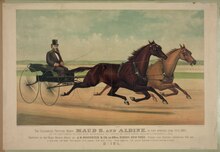
In the autumn of 1878 a man named Joseph Harker purchased an option to buy Maud S. for $20,000 if the horse managed a 2:20 mile as a four-year-old. Stone offered Bair, her trainer, $1,000 if she trotted the mile in 2:19. Maud S. trotted a time of 2:17 1/2 in Lexington, Kentucky on October 26, 1878, a time which was widely reported and considered to be the fastest ever by a four year old. [1] After obtaining the option from Harker, William Henry Vanderbilt purchased the horse at the increased price of $21,000. After a time Stone and Bair were allowed to continue managing and training Maud S.; Bair was also the driver. [2]

Maud S. first set the world record in 1880 at Rochester, New York at 2:11 3/4; they shared the record with "St. Julien". In 1881 Maud S. lowered the record for the third time, to 2:10 1/4. In 1884 Jay Eye See set a new record of 2:10 on August 1st in Providence, Rhode Island; on August 2nd Maud S. reclaimed the record with a time of 2:09 1/4 in Lexington. [3]
Maud S. was sold in 1884 to newspaper publisher Robert E. Bonner, a rival of the Vanderbilts in the racing world. One theory was that Maud S. was so famous that her owner was jealous of the attention she got when he took her out. [4] Maud S. set one last world record in 1885, 2:08 3/4 in Cleveland, Ohio, before being retired in that year.
Maud S.'s reputation continued well after her retirement; she was exhibited at Madison Square Garden in February 1900 shortly before her death and received an ovation. [5]
Maud S. died at the Shultshurst Farm in Port Chester, New York, New York and is buried in Tarrytown, New York next to "Dexter", another notable harness racer.
Maud S. was elected to the Harness Racing Hall of Fame in 1955. [6]
The Maud S Mine near Butte, Montana may have been named for Maud S., and it gave its name to the Maud S Canyon. [7] The Maud S Windmill & Pump Company of Lansing, Michigan was named after the horse. [8] The "Horse Collar King" John C. Lighthouse sold a patented Maud S horse collar. [9] Maud S.'s image or name was also used to sell a variety of commercial products, including nails, cigarettes, [10] patent medicine, [11] and flour. [12]

Maud S. was stabled at one time near Grand Central Station in New York City; there is a rumor that the mare's ghost appears in the station. [13] [14]

Harness racing is a form of horse racing in which the horses race at a specific gait. They usually pull a two-wheeled cart called a sulky, spider, or chariot occupied by a driver. In Europe, and less frequently in Australia and New Zealand, races with jockeys riding directly on saddled trotters are also conducted.

Greyhound was a grey Standardbred gelding by Guy Abbey out of Elizabeth by Peter the Great. Born in 1932, Greyhound was the outstanding trotting horse of his day and arguably the most outstanding in the history of the sport. He was nicknamed "The Great Grey Ghost" and "Silver-skinned Flyer." In 1935, he won the Hambletonian race and in 1938 he lowered the record time for trotting the mile to 1:55¼. This record stood until 1969.
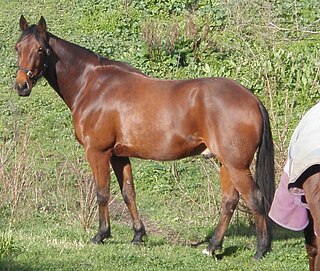
The Standardbred is an American horse breed best known for its ability in harness racing where they compete at either a trot or pace. Developed in North America, the Standardbred is recognized worldwide, and the breed can trace its bloodlines to 18th-century England. They are solid, well-built horses with good dispositions.

Yonkers Raceway & Empire City Casino, founded in 1899 as the Empire City Race Track, is a one-half-mile standardbred harness racing dirt track and slots racino located at the intersection of Central Park Avenue and Yonkers Avenue in Yonkers, New York, near the New York City border. It is owned by Vici Properties and operated by MGM Resorts International.
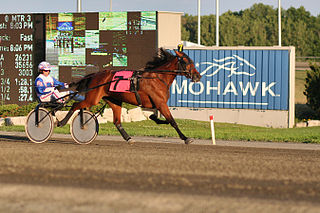
Mohawk Racetrack is a harness racing track in Campbellville, Ontario. It is owned by Woodbine Entertainment Group and is about 40 km southwest of the company's other racetrack, Woodbine Racetrack in Toronto, Ontario. Woodbine Mohawk Park also has a large slot machine parlour with over 1,000 slot machines, which is operated by Great Canadian Entertainment; some of the revenue from this operation is used to increase the horseracing purses. Ken Middleton is the longtime track announcer.

A sulky is a lightweight cart used for harness racing. It has two wheels and a small seat for only a single driver. The modern racing sulky has shafts that extend in a continuous bow behind the driver's seat, with wire-spoked "bike" wheels and inflated tyres. A sulky is frequently called a "bike". Historically, sulkies were built for trotting matches and made from wood with very tall wheels and almost no body, just a simple frame supporting a single seat. Such vehicles were called "sulkies" because they were "said to have been chosen by unsociable people fond of their own company or fits of sulking".

Harness racing, also colloquially known as trotting or the trots, is a spectator sport in Australia, with significant amounts of money wagered annually with bookmakers and the Totalisator Agency Board (TAB). In Australia there are 90 harness racing tracks, which hold over 1,900 meetings annually. There are approximately 2,900 drivers and 4,000 trainers with about 5,000 Standardbred horses foaled and registered each year.
The New Zealand Cup for standardbred horses, also known as either the New Zealand Trotting Cup or the New Zealand Pacing Cup is a Group One (G1) harness race held annually by the New Zealand Metropolitan Trotting Club at Addington Raceway in Christchurch, New Zealand.

Hanover Shoe Farms, Inc. is a North American Standardbred horse breeding facilities. Its history traces back to the early 1900s.
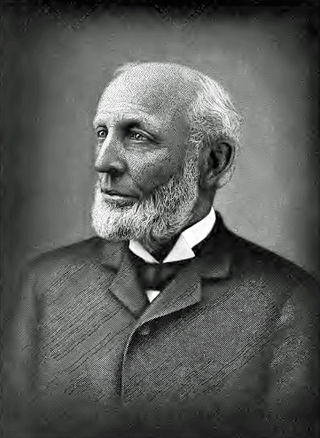
Jerome Increase Case was an early American manufacturer of threshing machines. He founded the J. I. Case Company which has gone through many mergers and name changes to today's Case Corporation. He served three terms as mayor of Racine, Wisconsin, and represented Racine County in the Wisconsin State Senate in 1865 and 1866. He also raised champion race horses.
The International Trot is a harness racing event held in the New York City area that aimed to appeal to a mix of United States and international entrants. The inaugural event was held at Roosevelt Raceway in Westbury, New York in 1959, and was held at the track until its closure in 1988. Thereafter, the race moved to Yonkers Raceway in Yonkers, New York. The initial running was held at a distance of 1.5 miles (2.4 km), with subsequent races held at a distance of 1.25 miles (2.01 km).
Harness racing in New Zealand is primarily a professional sport which involves pacing and trotting competitions for Standardbred racehorses. The difference is the horse's gait or running style:
Delightful Lady was a New Zealand Standardbred racemare.

The Brighton Beach Race Course was an American Thoroughbred horse racing facility in Brighton Beach, Brooklyn, New York, opened on June 28, 1879 by the Brighton Beach Racing Association. Headed by real estate developer William A. Engeman, who owned the Brighton Beach Hotel, the one-mile race track was located in back of the hotel and bounded by Ocean Parkway on the west, Neptune Avenue on the north, Coney Island Avenue on the east, and Brighton Beach Avenue on the south. An instant success, the race track drew wealthy patrons from New York City, and harness racing was introduced there in 1901.

John Edward Madden was a prominent American Thoroughbred and Standardbred owner, breeder and trainer in the late nineteenth and early twentieth century. He owned Hamburg Place Stud in Lexington, Kentucky and bred five Kentucky Derby and Belmont Stakes winners.

Goldsmith Maid was a prominent Standardbred racemare in the 1870s that was called the "Queen of the Trotters" and had a harness racing career that spanned 13 years. Her last race was won at the age of 20 against a much younger horse named Rarus. She was inducted into the Harness Racing Hall of Fame in 1953.
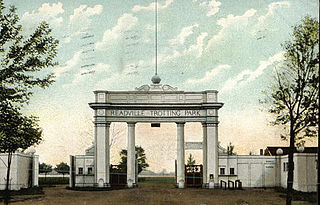
The Readville Race Track located in Readville, Massachusetts had a famous and exciting history for Harness Racing, Motorcycle Racing, Auto Racing and early military combat Aviation. When the track officially opened on August 25, 1896, it quickly became one of the premier venues for harness racing in the United States. It was known as one of the country's fastest courses and many records were broken there. In 1903 history was made at Readville when a five-year-old mare named Lou Dillon became the first trotter to run a two-minute mile. On August 25, 1908 the most spectacular event in all harness horse history was staged, the $50,000 American Trotting Derby won by Allan Winter.
Joseph Cyril O'Brien was a Harness racing driver, trainer and owner who won the U.S. Trotting Triple Crown in 1955 and would be inducted into both the U.S. Harness Racing Hall of Fame and the Canadian Horse Racing Hall of Fame, as well as Canada's Sports Hall of Fame. Noted for his quiet dignity and diplomacy, he is considered one of the greatest harness horsemen in history.

Fleetwood Park was a 19th-century harness racing (trotting) track in what is now the Morrisania section of the Bronx in New York, United States. The races held there were a popular form of entertainment, drawing crowds as large as 10,000 from the surrounding area. The one-mile (1.6 km) course described an unusual shape, with four turns in one direction and one in the other. For the last five years of operation, Fleetwood was part of trotting's Grand Circuit, one travel guide calling it "the most famous trotting track in the country".
The Race By Grins is a race for 3 year old and older harness horses run at Cambridge Raceway, New Zealand, by the Waikato Bay of Plenty Harness club. It is raced over 2200m from a mobile start and is a slot race.